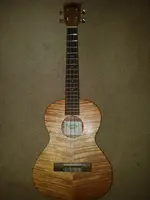R
Richard Monroe
Well-known member
OK, I really didn't really know what forum to stick this in, so here it is. For 35 years or so I've been hauling an acoustic or a hollowbody through airports, trying to talk them onto the airplane or (gulp) checking them as luggage! (United breaks guitars!). And what do I do this for? It used to be for gigs or sessions, but now it's mostly for plinking, maintaining calluses, and songwriting.
Well, I just spent 12 days on the big island of Hawai'i, and I actually bought a tenor uke! Where are you going to find a big ukulele store anyway? Be afraid, be very afraid. By Kala, a travel uke, it has a thin body but surprisingly, a pretty solid voice. Solid top Australian Acacia (the scientific name of Koa is Acacia Koa- they're pretty much the same tree). Nice bookend matched Acacia back and sides, simple appointments, made in China. It's the first hollowbody of any type I've played that was made in China that didn't suck. They're learning. I've never related to mandolin or banjo, but the Uke felt good right off the bat. My only promise is that I will not play "Tiptoe through the Tulips", or the theme song of "Gilligan's Island". Right now, I'm using it for vintage New England seafaring songs. Based on the Portuguese machete, it was a common sailor's instrument in the 18th and 19th centuries.
So I'm trying to figure out the strums for an instrument with reentrant tuning (high note strings in first *and* 4th position.) I'm planning on trying the low-G tuning, which requires switching out the 4th string for a G that's an octave lower. Then you can play a ton of 4-string lute and tenor guitar stuff.
Oh Boy! All new chord positions, but it's easier than guitar. 4 fingers, 4 strings, they're on to something there. The hard part is figuring out the real finger positions with half-bars. To make my big ol' fat fingers fit in those little spaces, I have to press more than one string with the same finger, when the chord diagrams show all 4 being used. Not. It's cool, though, like starting all over again, but with a clue. Just sharing.
Well, I just spent 12 days on the big island of Hawai'i, and I actually bought a tenor uke! Where are you going to find a big ukulele store anyway? Be afraid, be very afraid. By Kala, a travel uke, it has a thin body but surprisingly, a pretty solid voice. Solid top Australian Acacia (the scientific name of Koa is Acacia Koa- they're pretty much the same tree). Nice bookend matched Acacia back and sides, simple appointments, made in China. It's the first hollowbody of any type I've played that was made in China that didn't suck. They're learning. I've never related to mandolin or banjo, but the Uke felt good right off the bat. My only promise is that I will not play "Tiptoe through the Tulips", or the theme song of "Gilligan's Island". Right now, I'm using it for vintage New England seafaring songs. Based on the Portuguese machete, it was a common sailor's instrument in the 18th and 19th centuries.
So I'm trying to figure out the strums for an instrument with reentrant tuning (high note strings in first *and* 4th position.) I'm planning on trying the low-G tuning, which requires switching out the 4th string for a G that's an octave lower. Then you can play a ton of 4-string lute and tenor guitar stuff.
Oh Boy! All new chord positions, but it's easier than guitar. 4 fingers, 4 strings, they're on to something there. The hard part is figuring out the real finger positions with half-bars. To make my big ol' fat fingers fit in those little spaces, I have to press more than one string with the same finger, when the chord diagrams show all 4 being used. Not. It's cool, though, like starting all over again, but with a clue. Just sharing.
Last edited:



 Explain yourself!
Explain yourself!


